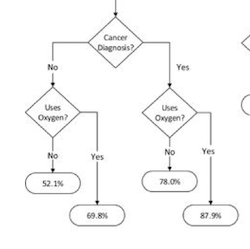Abstract
BACKGROUND: Newer analytic approaches for developing predictive models provide a method of creating decision support to translate findings into practice. OBJECTIVES: The aim of this study was to develop and validate a clinically interpretable predictive model for 12-month mortality risk among community-dwelling older adults. This is done by using routinely collected nursing assessment data to aide homecare nurses in identifying older adults who are at risk for decline, providing an opportunity to develop care plans that support patient and family goals for care. METHODS: A retrospective secondary analysis of Medicare and Medicaid data of 635,590 Outcome and Assessment Information Set (OASIS-C) start-of-care assessments from January 1, 2012, to December 31, 2012, was linked to the Master Beneficiary Summary File (2012-2013) for date of death. The decision tree was benchmarked against gold standards for predictive modeling, logistic regression, and artificial neural network (ANN). The models underwent k-fold cross-validation and were compared using area under the curve (AUC) and other data science metrics, including Matthews correlation coefficient (MCC). RESULTS: Decision tree variables associated with 12-month mortality risk included OASIS items: age, (M1034) overall status, (M1800-M1890) activities of daily living total score, cancer, frailty, (M1410) oxygen, and (M2020) oral medication management. The final models had good discrimination: decision tree, AUC = .71, 95% confidence interval (CI) [.705, .712], sensitivity = .73, specificity = .58, MCC = .31; ANN, AUC = .74, 95% CI [.74, .74], sensitivity = .68, specificity = .68, MCC = .35; and logistic regression, AUC = .74, 95% CI [.735, .742], sensitivity = .64, specificity = .70, MCC = .35. DISCUSSION: The AUC and 95% CI for the decision tree are slightly less accurate than logistic regression and ANN; however, the decision tree was more accurate in detecting mortality. The OASIS data set was useful to predict 12-month mortality risk. The decision tree is an interpretable predictive model developed from routinely collected nursing data that may be incorporated into a decision support tool to identify older adults at risk for death.
BibTex
@article{Sullivan2019,
author="Sullivan, Suzanne S and Hewner, Sharon and Chandola, Varun and Westra, Bonnie L",
year="2019",
journal="Nurs Res",
year="2019",
volume="68",
number="2",
pages="156--166",
}
